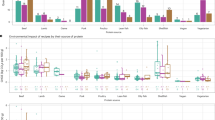Abstract
This study compared nutrient intakes from 7-day menus for the US MyPlate and DASH Eating Plan versus the cutoff points for green lights defined by the UK’s multiple traffic light (MTL) scheme. For both diets, the foods achieved green lights for saturated fat and salt, and for beverages for total fat, saturated fat and salt. The other nutrients achieved amber lights but were within the range of the two diets. By contrast, the MTL threshold for salt in beverages was outside the range of the diets. The values for salt in beverages in the MyPlate and Dash diet plans were 0.06±0.07 and 0.19±0.01 (s.d.) g/100 ml, which are both considerably lower compared with the cutoff of 0.3 g/100 ml for an MTL green light. Adjusting the green MTL threshold values to the median values for a healthful diet could help make MTL labelling a more valid way of helping consumers choose a healthful diet.
This is a preview of subscription content, access via your institution
Access options
Subscribe to this journal
Receive 12 print issues and online access
$259.00 per year
only $21.58 per issue
Buy this article
- Purchase on Springer Link
- Instant access to full article PDF
Prices may be subject to local taxes which are calculated during checkout
Similar content being viewed by others
References
World Health Organization. Global status report on noncommunicable diseases 2014 2014, Available at http://apps.who.int/iris/bitstream/10665/148114/1/9789241564854_eng.pdf?ua=1 (accessed on 12 February 2015).
UK Government. Guide to creating a front of pack (FoP) nutrition label for pre-packed products sold through retail outlets 2013, Available at https://www.gov.uk/government/uploads/system/uploads/attachment_data/file/300886/2902158_FoP_Nutrition_2014.pdf (accessed on 15 May 2015).
Townsend MS . Where is the science? What will it take to show that nutrient profiling systems work? Am J Clin Nutr 2010; 91: 1109S–1115S.
Scarborough P, Boxer A, Rayner M, Stockley L . Testing nutrient profile models using data from a survey of nutrition professionals. Public Health Nutr 2007; 10: 337–345.
US Department of Agriculture. Sample Menus for a 2000 Calorie Food Pattern. Available at http://www.choosemyplate.gov/food-groups/downloads/Sample_Menus-2000Cals-DG2010.pdf (accessed on 15 May 2015).
NHLBI, NIH. Your Guide to Lowering Your Blood Pressure with DASH—A Week with the DASH Eating Plan 2015, Available at http://www.nhlbi.nih.gov/health/resources/heart/hbp-dash-week-dash-html (accessed on 12 February 2015).
US Department of Agriculture. National Nutrient Database for Standard References (Release 27) 2015, Available at http://ndb.nal.usda.gov/ndb/search/list (accessed on 15 May 2015).
Joint WHO/FAO Expert Consultation. Diet, nutrition and the prevention of chronic diseases. World Health Organization: Geneva, Switzerland, 2003, (WHO Technical Report Series, No. 916).
US Office of Disease Prevention and Health Promotion. Scientific Report of the 2015 Dietary Guidelines Advisory Committee. Available at http://www.health.gov/dietaryguidelines/2015-scientific-report/ (accessed on 15 May 2015).
Ledikwe JH, Blanck HM, Kettel Khan L, Serdula MK, Seymour JD, Tohill BC et al. Dietary energy density is associated with energy intake and weight status in US adults. Am J Clin Nutr 2006; 83: 1362–1368.
Author information
Authors and Affiliations
Corresponding author
Ethics declarations
Competing interests
The authors are, or have been, employed by Nestlé SA, Vevey, Switzerland.
Additional information
Author contributions
HG conceived and carried out the study, performed data analysis and drafted the manuscript. EF carried out the study, performed data analysis and helped draft the manuscript. Both authors approved the final version of the article including authorship.
Supplementary Information accompanies this paper on European Journal of Clinical Nutrition website
Supplementary information
Rights and permissions
About this article
Cite this article
Green, H., Fern, E. Comparison of nutrient intakes from two selected diet plans considered healthful versus the cutoff points for green lights as defined by the UK’s multiple traffic light scheme. Eur J Clin Nutr 70, 277–279 (2016). https://doi.org/10.1038/ejcn.2015.125
Received:
Revised:
Accepted:
Published:
Issue Date:
DOI: https://doi.org/10.1038/ejcn.2015.125



